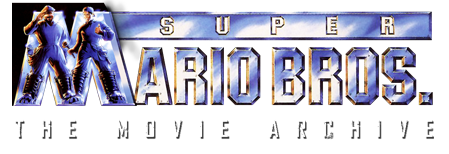Interview--Rob Burman (Koopa Creature)
Conducted by: Ryan Hoss and Steven Applebaum
October 17, 2010 (Updated 1/7/2012)
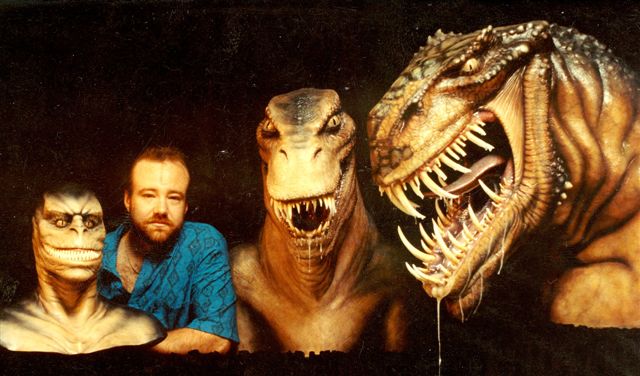
Rob Burman
It's probably no mystery to those that frequent this website that the "Demise of King Koopa" sequence during the climax of Super Mario Bros. is one of my favorite moments of the entire film. So, being able to speak with Rob Burman--the man behind the production of the Koopa Creature--was an extremely gratifying experience for me.
What follows is Rob's account of his involvement with the film. Cool factor aside, since Koopa's de-evolution was decided upon very late into production, we learn some really interesting tidbits not found anywhere else. Enjoy!
Ryan Hoss: Could you tell us a bit about yourself and how you got into makeup effects and sculpting, and the film industry?
Rob Burman: My Grandfather studied in Chicago and became a commercial artist and sculptor. During the 1930’s he created several monuments and sculptures around the Lincoln and Omaha, Nebraska areas. In 1939 he moved to California to see if he could find work in the “moving picture” industry. In 1941 he created the silver headed wolf cane that they use to kill the Wolfman. On weekends, summers and holidays, my Father had to help out in the shop making molds and casting parts for the props my Grandfather was making. Rubber guns, knives, fish, cakes – anything they needed a prop of.
In 1966 my Father was accepted as an apprentice and 20th Century Fox under Ben Nye. He was picked over the other 96 applicants because he had some lab experience making molds. While working there on shows like Lost in Space, Batman and Time Tunnel, he overheard Ben Nye talking about needing the guy that did all of the lab work for “The List Of Adrien Messenger”. My Father told them it was John Chambers and they brought him in. John and my Dad stared on a 4’x 8’ table making sculptures, molds, castings – everything for this new film they were calling “Planet Of The Apes”.
John and my Father eventually moved off the studio lot in the early 1970’s to start their own – and the very first – make-up lab off the lot. My Dad and his brother Sonny bought out John and then my Dad bought out my uncle. Hence, The Burman Studio.
I started by coming in at night to clean the shop in 1979. My Father would call me at school the next day asking where I put things and then had me start coming in after school. Once I graduated from school, I stayed on and became foreman in very short order (I was the only one that knew where everything was!).
I left The Burman Studio in late 1981 to work for Rob Bottin on “The Thing” and have been freelancing and running my own shows ever since.
RH: How familiar were you with the Super Mario Bros. games before you worked on the film?
RB: I was aware of the video game but never played it (or any others for that matter). I knew some of the people contacted for the first attempt at the movie but wasn’t involved then.
RH: When in the film’s development process did you become involved with Super Mario Bros.?
RB: I stepped in after most of the other FX artists had been contracted. I knew Patrick Tatopoulos from working on Star Trek 5. He had always wanted to work with me on something. When they had decided how they wanted the King Koopa’s Demise would look, Patrick involved me and my good friend Bud McGrew (Who is a mechanical wizard!). I was contracted to create the cosmetics and Bud, the mechanics. We had 13 weeks to do the work, then 3 weeks to film it.
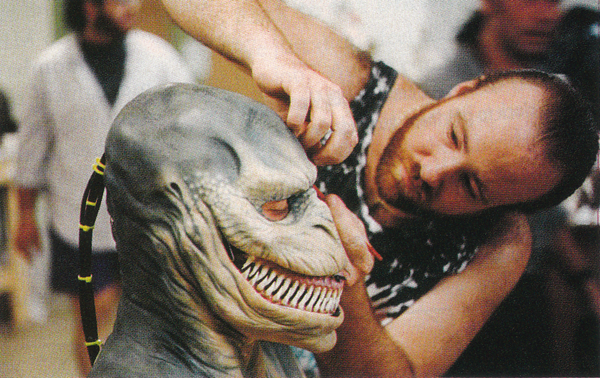
"We had 13 weeks to do the work, then 3 weeks to film it."
RH: Based on some other interviews we've had, we've been told that the entire "Demise of King Koopa" scene wasn't in the original script and was devised late into production. Do you know what the filmmakers originally had planned for the climax of the film?
RB: As far as "King Koopa's Demise" is concerned, I think that they hadn't really worked out exactly what they wanted to do to end the movie. The first incarnation of the film was very different in tone and story from what I understand. It kind of felt like Production was kind of flying by the seat of their pants to figure out what this version was going to be like.
RH: Apparently, a lot of design companies made pitches to develop the Goombas in the film—and Makeup and Effects Lab (MEL) got the job after submitting a prototype to the producers when they were afraid that they wouldn’t get the job. What was your experience like in getting the gig to design the Koopa Creature effects? Were you approached for the job, or were there other companies in competition?
RB: I have no idea if they had contacted anyone else. Probably not since Patrick was the creature designer and was part of my crew sculpting the transformation heads.
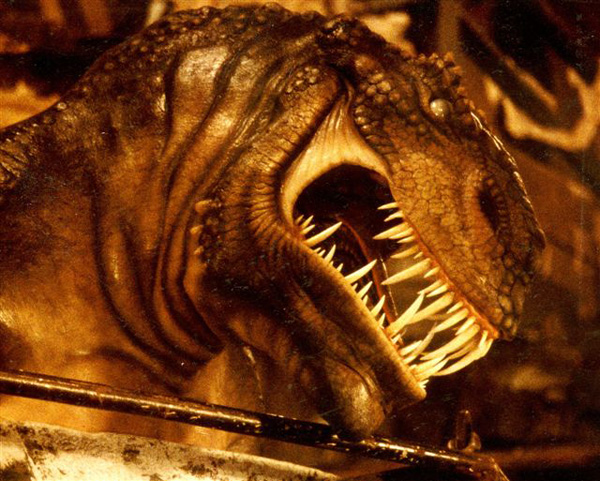
"I think that they hadn't really worked out exactly what they wanted to do to end the movie."
RH: In creating these different stages of Koopa’s de-evolution, you worked from Patrick Tatopoulos’s designs. What were those like? Did you meet with him while developing your work? It seems like the creature Koopa de-evolves into is very closely linked to the same physiology and structure from other creatures in the film, such as Yoshi and the Goombas—only on a more extreme scale.
RB: Patrick provided me with drawings. In fact, he personally sculpted the second stage prosthetic make-up as well as the 4th stage puppet head. I did the first stage prosthetic that Dennis Hopper wore and the third stage puppet head. He was in the shop most of the first half of our build and then I took over the rest with my small crew.
RH: Did Patrick Tatopoulos's designs for Koopa's de-evolved forms differ at all from the final pieces? Were they full-body designs or were they all conceived as "heads only" from the beginning?
RB: Since Patrick was sculpting for me on these figures, it was pretty much what he wanted. The drawings he presented to us were reasonably close to the finished product. (Although if you watch the last Godzilla movie, it was pretty much the third stage Koopa puppet in full figure).
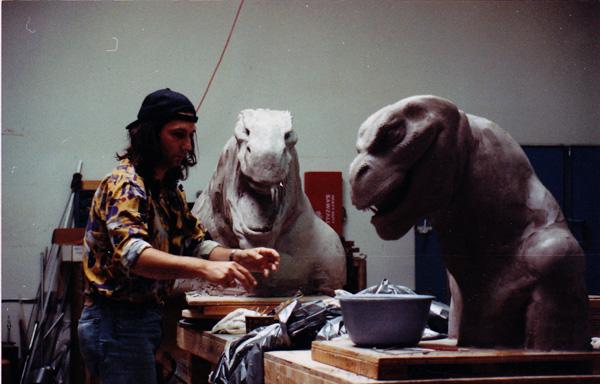
Patrick Tatopoulos, working on sculpts for the Koopa Creature
RH: Could you describe the development of all four stages of Koopa’s de-evolution, and what it took to make them a reality?
RB: Stage one: A large, lizard-like smile prosthetic on Dennis Hopper.
Stage two: A prosthetic overhead with a plastic mouth insert and radio-controlled lip-pulls to enhance the smile and full contacts. This was put on a different performer that was more the right body shape for Koopa.
Stage three: A Dinosaur-like radio controlled puppet with an additional operator underneath for the larger head movements (Me!).
Stage four: A larger radio-controlled puppet head looking more T-Rex-like. After that, it was all CG animation. 13 weeks of work for 13 seconds of screen time.

"13 weeks of work for 13 seconds of screen time."
RH: In the film, Koopa is briefly placed in the Devo Chamber and notices his regression at one point in the film—and when this happens, he starts to look slightly like his “stage two” de-evolution from the end of the film. There were more instances of this happening in the original script—do you know if any of these were filmed or tested?
RB: I believe that they just took elements from the shoot we did for the end and added them in with CG. We didn’t do any special shooting for those scenes.
RH: I have a question about the stage one makeup application, which involved Dennis Hopper: did the plastic prosthetic jaw allow Dennis to move his mouth, or was this purely cosmetic and used primarily to morph the other stages together?
RB: The first stage on Dennis was a mouth and cheek prosthetic. Relatively comfortable. The next stage was on a different performer and it contained an inner fiberglass helmet that incorporated the teeth and gave us something to attach the radio-controlled cables to. All he had to do was open his mouth and wear the contact lenses. Almost forgot, we also made gloved hands for this stage.
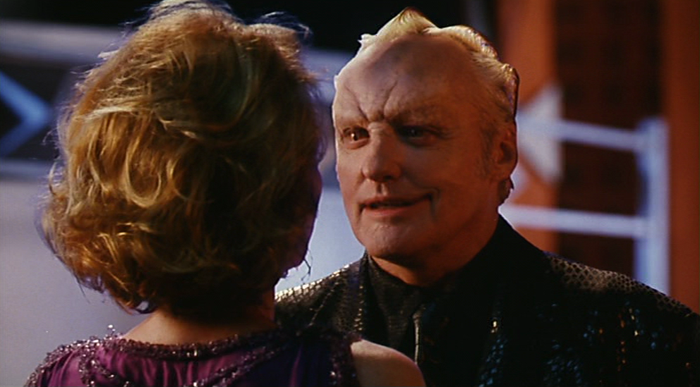
"They took elements from the shoot we did for the end and added them in with CG."
RH: From my research on your work on the film, it seems like each stage of Koopa’s de-evolution had some level of extra interactivity and function that didn’t exactly end up on film—such as the snarling, radio-controlled mouth of the stage two creature, or the blinking eyes of the stage three T-Rex. Could you elaborate on these additional functions, and your thoughts on why they were underutilized in the final film?
RB: Bud had dozens of movements in those heads. They were made so the foreheads would push in and out, muzzles stretched – all kinds of things that enhance a transformation effect. In the end, the movements weren’t as broad as expected due to the constrictive nature of putting a foam latex skin over the top of it. I think that when they viewed what the puppets could do, they opted to add in more CG.
RH: You may have already answered this in a previous question, but did the stage two Koopa have a tongue? If so, did it have any sort of movement or function? There are two reasons I’m asking this. First, because in the film both Koopa and Yoshi are a species of T-Rex, and Yoshi has an extending tongue. Second, in the original script, the Koopa creature in the climax has a long tongue—similar to Yoshi’s—with which to threaten Mario.
RB: Nope, no tongue. It was always going to be CG if they were going to have one.
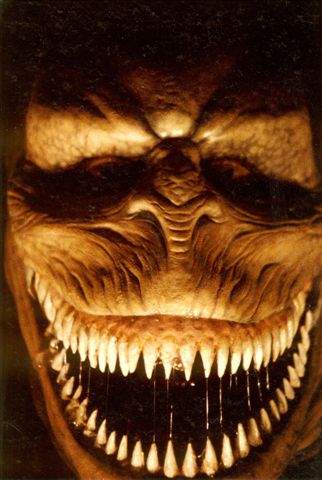
"Nope, no tongue. It was always going to be CG if they were going to have one."
RH: Was any thought given to add perhaps some T-Rex arms or a tail for the wide shot in the film to sell that there was a full T-Rex in that bucket?
RB: There was brief discussion about creating a little more of the puppets body forms but it was quickly decided it wasn't necessary since it would be hidden by the cement bucket he was hanging in. Most likely due to budgetary and time constraints that were presented due to the lateness of our involvement.
RH: Unfortunately, the four stages of Koopa’s de-evolution were seen on film for less than one minute. Combined with details from earlier drafts and the extra functionality built into your effects, it would seem that there could have been more screen time with them. Were there any plans for additional scenes or setups with these effects that were altered or changed?
RB: At the point I got to location in North Carolina, most everyone was wanting the project to be over. The Directors quit the day I arrived and Dean Semler directed everything we did. I think they were all interested in just getting it done.
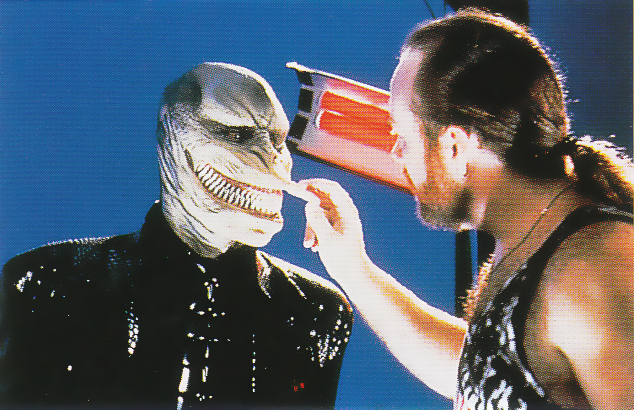
"I think they were all interested in just getting it done."
RH: Did you work with the CG effects department to help assist them with the morphing process of Koopa’s four stages?
RB: We all conferred together but in the end, it was whatever they wanted to do.
RH: Do you have any idea if the final, computer generated version of the T-Rex Koopa that you see in the film was designed with the Koopa game characters’ color scheme in mind? It certainly looks that way.
RB: We tried a couple of paint schemes on it that were interesting but unrealistic. I think it was just a case of trying to make it look kind of natural as well as being shark-like.
SA: In regards to your above statement, what do you mean by "shark-like"? Was the Koopa creature specifically influenced by sharks, or was it simply a fair comparison because of their shared quality of having a toothy grin?
RB: There was a lot of discussion about the coloration on Koopa at the last minute. It started out a little more patterned and tribal. As the discussions went on and we were not happy with the paint tests, Patrick started to come up with the shark comparison. It's an homage to the kind of character that he was I believe.
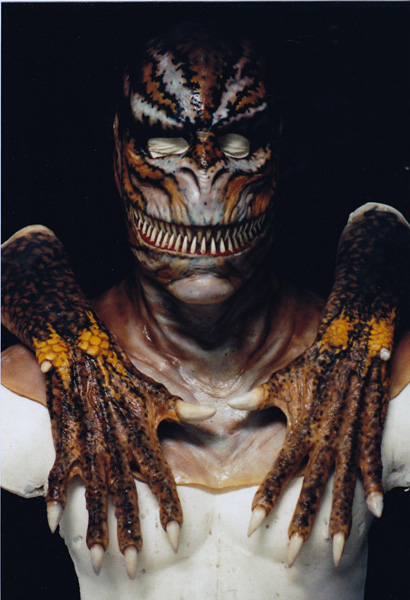
The more "patterned and tribal" initial paint test for Stage 2 Koopa. Quite an interesting departure...
RH: From my understanding, you were on-hand during the filming of “King Koopa’s Demise.” How was this shoot performed? Was this scene shot by a main unit or second unit?
RB: Everything we did was first unit but only because the second unit took over at that point due to Rocky and Annabel leaving. I hung in the cement bucket that the stages 3 and 4 puppets were in for two days. Made me a little sea-sick. The Stage 1 prosthetic was shot on the catwalks with Dennis and the stage 2 was shot in front of bluescreen.
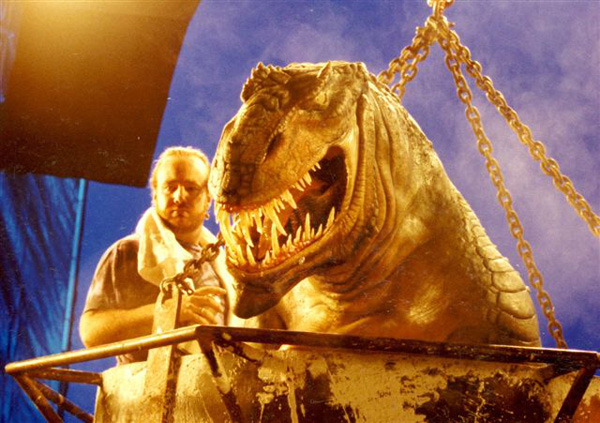
"I hung in the cement bucket that the stages 3 and 4 puppets were in for two days. Made me a little sea-sick."
SA: Vincent Guastini, the special effects makeup artist on the film who also worked on the slime used for Koopa's demise, stated that Patrick Tatopolous was considering invited him to L.A. to do a complete reshoot of Koopa's demise with more T. rex and primordial creature "stages." Did you hear anything about this?
RB: Never heard a thing about it (And Patrick probably didn't want me to know!). I had always thought the transformation could use more stages as well as stages that did more "stuff" as far as twisting and deforming. Mechanically speaking, I understand that Patrick was disappointed in the final result. It didn't seem to "transform" as much as he would have liked. The CGI guys had always planned on a lot of blending between stages but the somewhat lack of movement made it a little awkward in my eyes.
RH: What was your interaction like with the directors? (It has come to our attention that after a certain point in production, Rocky Morton and Annabel Jankel left the project—I’m not sure where your part in the film played into this timeline).
RB: I met them a couple of times but don’t remember any specific direction that I received from them. Patrick was the design guy and we followed his lead. Rocky and Annabel’s last day was the day I arrived on set.
RH: Do you know of any other alternate or deleted footage not found in the final film?
RB: Not a clue.
SA: Craig Edwards, a production assistant and featured extra, was on-set for the shoot of Koopa's demise. He said that more was shot, including spectacular takes of the stage 2 Koopa being exploded by the Bob-Omb. Do you remember if anything additional or better was shot for the Demise?
RB: Actually, during the filming of the stuff with Dennis Hopper in the first stage, I was prepping the puppets for the next few stages. I had Jake Garber do Dennis' make-up so he was covering set for me. The stage 2 make-up on the Koopa "body double" was shot then too so I don't really know much about what was shot. They did, apparently, shoot quite a bit but it was mostly variations on the same stuff you see in the film.
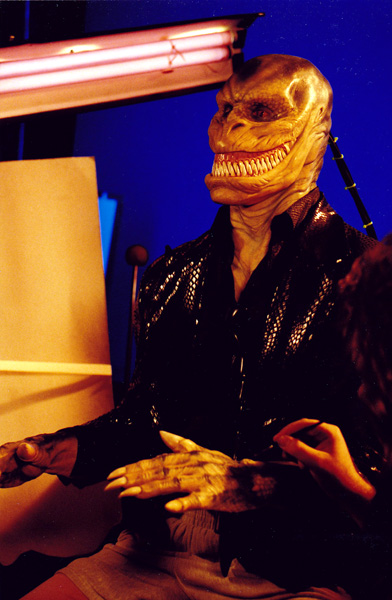
Blue-screen setup for a Stage 2 Koopa shot
SA: If you had had more time or money, what would you have liked to do bigger or better for the prosthetic Koopa stages and the climax in general?
RB: I'm not sure that it was a time or money thing so much as a re-planning of the scene and it's stages of transformation. I would have liked to see more variations in the stages and I would have liked to see the stages distort more between the CGI "blending". Bud McGrew made, and makes, some AMAZING mechanisms and puppets. I think that at the time he didn't quite understand the extremes that were expected of the puppets and the overall movement was affected by that.
SA: What do you think of MEL's work on the Goombas and Allosaurus rats and Dave Nelson's work on Yoshi? How do you feel they compare to your work?
RB: I think that their work on the film was some of MEL's best work to date. They did a nice job and proved vey reliable. Dave Nelson's Yoshi was a stupendous piece of work. Probably the best work in the film over all. If it wasn't so tricky to "perform" with and require so many puppeteers, it may have gotten more screen time - which I think it deserved.
SA: How would you have approached working on the Goombas, Allosaurus Rats or Yoshi if you had been offered those creatures instead of or as well as the Koopa Creature?
RB: I believe the thing that makes me special in my industry is that I have extensive experience in every stage of what I do. Some people specialize and become really good at a thing. I do it all. There are people that do things better than me but rarely can they do EVERYTHING that is needed. This makes me uniquely suited to be the "leader" on a job. The smartest and best thing I can do, therefore, is to hire the right people to get the work done.
It takes a good number of people to make a project happen. Hiring "giants" to do the work, rather than "midgets" will get the job done well and make you look good. Both Bud and I had small crews and limited time and resources. Expanding that would be my first step given the opportunity.
RH: Do you have any funny or interesting stories about your experience on the film?
RB: Other than arriving for work and having your boss’ quit? Or maybe being on location for 3 weeks and only shooting for 4 days? It was actually the first project I had that forced me to move in to a proper shop space instead of my garage shop. It was a good starter to be sure.
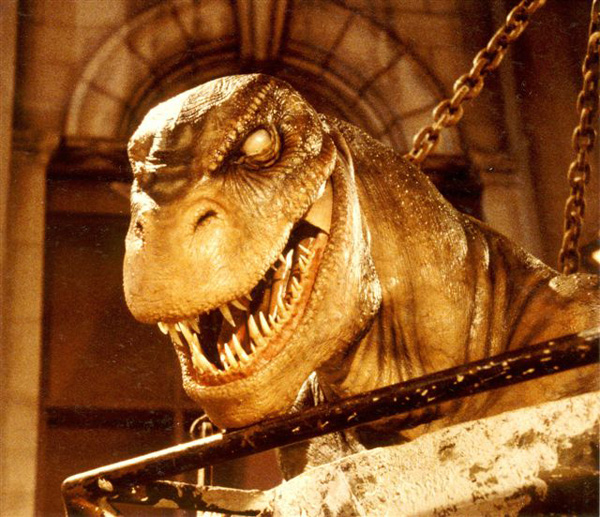
"It was a good starter to be sure."
RH: Did you get to attend the film’s premiere?
RB: To be honest, I don’t remember if there was even a crew showing. I know they did a lot publicity-wise in Japan because they had me make display copies of the transformation heads that I still have.
RH: What did you think of the film when you first saw it?
RB: Well, if I’m going to be honest, it was pretty disappointing. My work flashes by so [that] gets disheartening and, overall, the whole film reflected the chaos of the production. A good idea spoiled by no true “leader” to make it happen.
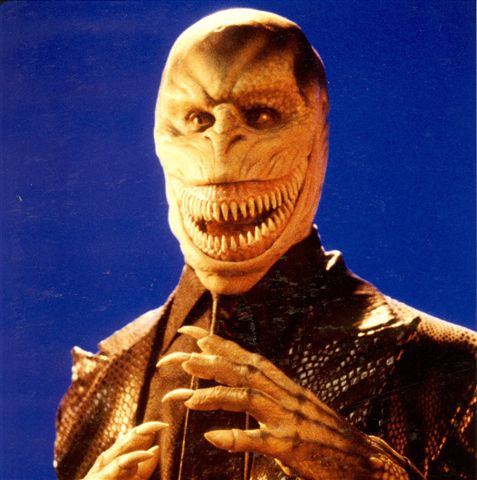
"The whole film reflected the chaos of the production. A good idea spoiled by no true "leader" to make it happen."
RH: What do you think of it now?
RB: Difficult to sit through…
RH: What are you up to these days?
RB: I still do a little film and television work. Mostly I sculpt and sell my pieces in galleries. My Signature Series is a line of limited edition, life-like figures ( Butlers , Maids, Servers, etc.). My Grotesque Series is based on drawings by Leonardo DaVinci cast in bronze. I’ve got several other pieces in various materials as well. Some of it can be seen on my website
http://www.robburmansculpture.com
Lastly I am producing over-the-counter, generic prosthetics called Rubber Wear http://www.getrubberwear.com. It gives people an affordable prosthetic without the lead time necessary to create your own.
I've gotta give another big thanks to Rob for doing this interview for us--thanks for letting us take a closer look at this underutilized part of the film!
